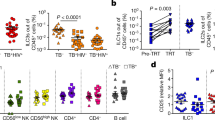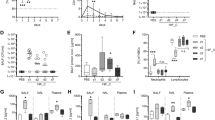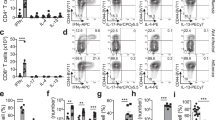Abstract
Chemokines and their receptors are important mediators of leukocyte trafficking and recruitment and sometimes work as modulators of T-cell responses during infections and inflammation. Modulating the biological activity of chemokines has been found to influence the course of diseases. However, little is known about the role of chemokine responses during chlamydial lung infections. We therefore analyzed the dynamics of multiple chemokines, which are frequently associated with type 1 (Th1) T cell immune responses, and their receptors for their expression in the lungs during Chlamydia muridarum (Cm) infections. We also examined the relationship between chemokine responses and the development of Th1 responses as well as the clearance of infection. Our results showed that in parallel with the high levels of gamma interferon (IFN-γ) and IL-12 production in the lungs and draining lymph nodes, and the expansion of IFN-γ-producing CD4 and CD8+ T cells, the production of the cell-related chemokines RANTES, IFN-γ-inducible protein-10 (IP-10) and macrophage inflammatory protein-1α (MIP-1α) and their receptor CCR1 was elevated in the lung tissues after infection. Interestingly, in a later phase of infection, the expression of RANTES and IP-10 remained elevated but the expression of MIP-1α and CCR1 decreased to a low level, which suggests a closer association with the pattern of Th1 cytokine responses in the process of infection. These results suggest a close association between the MIP-1α response and the Th1-type T-cell responses in chlamydial lung infections.
This is a preview of subscription content, access via your institution
Access options
Subscribe to this journal
Receive 12 digital issues and online access to articles
$119.00 per year
only $9.92 per issue
Buy this article
- Purchase on Springer Link
- Instant access to full article PDF
Prices may be subject to local taxes which are calculated during checkout





Similar content being viewed by others
References
Grayston JT . Background and current knowledge of Chlamydial pneumoniae and atherosclerosis. J Infect Dis 2000; 181: 402–410.
Kuo CC, Jackson LA, Campbell LA, Grayston JT . Chlamydial pneumoniae (TWAR). Clin Microbiol Rev 1995; 8( 4): 451–461.
Hahn DL, Dodge RW, Golubjatnikov R . Association of Chlamydial pneumoniae (strain TWAR) infection with wheezing, asthmatic bronchitis, and adult-onset asthma. JAMA 1991; 266( 2): 225–230.
von Hertzen L, Alakarppa H, Koskinen R, Liippo K, Surcel HM, Leinonen M et al. Chlamydial pneumoniae infection in patients with chronic obstructive pulmonary disease. Epidemiol Infect 1997; 118( 2): 155–164.
Sriram S, Stratton CW, Yao S, Tharp A, Ding L, Bannan JD et al. Chlamydial pneumoniae infection of the central nervous system in multiple sclerosis. Ann Neurol 1999; 46( 1): 6–14.
Brunham RC, Rey-Ladino J . Immunology of Chlamydial infection: implications for a Chlamydia trachomatis vaccine. Nat Rev Immunol 2005; 5( 2): 149–161.
Morrison RP, Caldwell HD . Immunity to murine chlamydial genital infection. Infect Immun 2002; 70( 6): 2741–2751.
Telyatnikova N, Hill Gaston JS . Prior exposure to infection with Chlamydial pneumoniae can influence the T-cell-mediated response to Chlamydia trachomatis. FEMS Immunol Med Microbiol 2006; 47( 2): 190–198.
Mygind T, Vandahl B, Pedersen AS, Christiansen G, Hollsberg P, Birkelund S . Identification of an in vivo CD4+ T cell-mediated response to polymorphic membrane proteins of Chlamydial pneumoniae during experimental infection. FEMS Immunol Med Microbiol 2004; 40( 2): 129–137.
Rottenberg ME, Gigliotti Rothfuchs A, Gigliotti D, Ceausu M, Une C, Levitsky V et al. Regulation and role of IFN-gamma in the innate resistance to infection with Chlamydial pneumoniae. J Immunol 2000; 164( 9): 4812–4818.
Penttila JM, Anttila M, Varkila K, Puolakkainen M, Sarvas M, Makela PH et al. Depletion of CD8+ cells abolishes memory in acquired immunity against Chlamydial pneumoniae in BALB/c mice. Immunology 1999; 97( 3): 490–496.
Lillard JW, Singh UP, Boyaka PN, Singh S, Taub DD, McGhee JR . MIP-1alpha and MIP-1beta differentially mediate mucosal and systemic adaptive immunity. Blood 2003; 101: 807–814.
Lillard JW, Boyaka PN, Taub DD, McGhee JR . RANTES potentiates antigen-specific mucosal immune responses. J Immunol 2001; 166: 162–169.
Sadek MI, Sada E, Toossi Z, Schwander SK, Rich EA . Chemokines induced by infection of mononuclear phagocytes with mycobacteria and present in lung alveoli during active pulmonary tuberculosis. Am J Respir Cell Mol Biol 1998; 19( 3): 513–521.
Luther SA, Cyster JG . Chemokines as regulators of T cell differentiation. Nat Immunol 2001; 2( 2): 102–107.
Dufour JH, Dziejman M, Liu MT, Leung JH, Lane TE, Luster AD . IFN-gamma-inducible protein 10 (IP-10; CXCL10)-deficient mice reveal a role for IP-10 in effector T cell generation and trafficking. J Immunol 2002; 168( 7): 3195–3204.
Darville T, Andrews CW Jr, Sikes JD, Fraley PL, Braswell L, Rank RG . Mouse strain-dependent chemokine regulation of the genital tract T helper cell type 1 immune response. Infect Immun 2001; 69( 12): 7419–7424.
Culley FJ, Pennycook AM, Tregoning JS, Dodd JS, Walzl G, Wells TN et al. Role of CCL5 (RANTES) in viral lung disease. J Virol 2006; 80( 16): 8151–8157.
Medoff BD, Sauty A, Tager AM, Maclean JA, Smith RN, Mathew A et al. IFN-γ-inducible protein 10 (CXCL10) contributes to airway hyperreactivity and airway inflammation in a mouse model of asthma. J Immunol 2002; 168: 5278–5286.
Joyee AG, Qiu H, Wang S, Fan Y, Bilenki L, Yang X . Distinct NKT cell subsets are induced by different Chlamydia species leading to differential adaptive immunity and host resistance to the infections. J Immunol 2007; 178( 2): 1048–1058.
Yang X, HayGlass KT, Brunham RC . Genetically determined differences in IL-10 and IFN-gamma responses correlate with clearance of Chlamydia trachomatis mouse pneumonitis infection. J Immunol 1996; 156( 11): 4338–4344.
Barron AL, White HJ, Rank RG, Soloff BL, Moses EB . A new animal model for the study of Chlamydia trachomatis genital infections: infection of mice with the agent of mouse pneumonitis. J Infect Dis 1981; 143( 1): 63–66.
Wang S, Fan Y, Brunham RC, Yang X . IFN-gamma knockout mice show Th2-associated delayed-type hypersensitivity and the inflammatory cells fail to localize and control chlamydial infection. Eur J Immunol 1999; 29( 11): 3782–3792.
Yang X, Gartner J, Zhu L, Wang S, Brunham RC . IL-10 gene knockout mice show enhanced Th1-like protective immunity and absent granuloma formation following Chlamydial trachomatis lung infection. J Immunol 1999; 162( 2): 1010–1017.
Geng Y, Berencsi K, Gyulai Z, Valyi-Nagy T, Gonczol E, Trinchieri G . Roles of interleukin-12 and gamma interferon in murine Chlamydial pneumoniae infection. Infect Immun 2000; 68( 4): 2245–2253.
Yang ZP, Kuo CC, Grayston JT . A mouse model of Chlamydial pneumoniae strain TWAR pneumonitis. Infect Immun 1993; 61( 5): 2037–2040.
Siveke JT, Hamann A . T helper 1 and T helper 2 cells respond differentially to chemokines. J Immunol 1998; 160( 2): 550–554.
Schrum S, Probst P, Fleischer B, Zipfel PF . Synthesis of the CC-chemokines MIP-1alpha, MIP-1beta, and RANTES is associated with a type 1 immune response. J Immunol 1996; 157( 8): 3598–3604.
Darville T, Andrews CW Jr, Sikes JD, Fraley PL, Braswell L, Rank RG . Mouse strain-dependent chemokine regulation of the genital tract T helper cell type 1 immune response. Infect Immun 2001; 69( 12): 7419–7424.
Shaw JH, Grund VR, Durling L, Caldwell HD . Expression of genes encoding Th1 cell-activating cytokines and lymphoid homing chemokines by Chlamydia-pulsed dendritic cells correlates with protective immunizing efficacy. Infect Immun 2001; 69( 7): 4667–4672.
Rasmussen SJ, Eckmann L, Quayle AJ, Shen L, Zhang YX, Anderson DJ et al. Secretion of proinflammatory cytokines by epithelial cells in response to Chlamydial infection suggests a central role for epithelial cells in chlamydial pathogenesis. J Clin Invest 1997; 99( 1): 77–87.
Olszewski MA, Huffnagle GB, McDonald RA, Lindell DM, Moore BB, Cook DN et al. The role of macrophage inflammatory protein-1 alpha/CCL3 in regulation of T cell-mediated immunity to Cryptococcus neoformans infection. J Immunol 2000; 165( 11): 6429–6436.
Trifilo MJ, Bergmann CC, Kuziel WA, Lane TE . CC chemokine ligand 3 (CCL3) regulates CD8+-T-cell effector function and migration following viral infection. J Virol 2003; 77( 7): 4004–4014.
Olszewski MA, Huffinagle GB, McDonald RA, Toews GB . The role of macrophage inflam-matory protein-1α/CCL3 in regulation of T cell-mediated immunity to Cryptococcus neoformans infection. J Immunol 2000; 165: 6429–6436.
Karpus WJ, Kennedy KJ . MIP-1a and MCP-1 differentially regulate acute and relapsing autoimmune encephalomyelitis as well as Th1/Th2 lymphocyte differentiation. J Leukocyte Biol 1997; 62: 681
Acknowledgements
This work was supported by a fund from the Tianjin Municipal Science and Technology Commission (07JCYBJC10600).
Author information
Authors and Affiliations
Rights and permissions
About this article
Cite this article
Zhang, N., Wang, Z., Tang, X. et al. Type 1 T-cell responses in chlamydial lung infections are associated with local MIP-1α response. Cell Mol Immunol 7, 355–360 (2010). https://doi.org/10.1038/cmi.2010.32
Received:
Revised:
Accepted:
Published:
Issue Date:
DOI: https://doi.org/10.1038/cmi.2010.32



